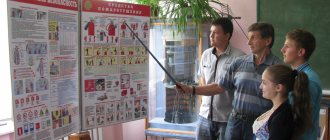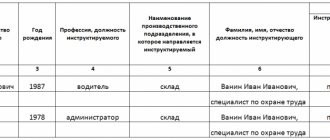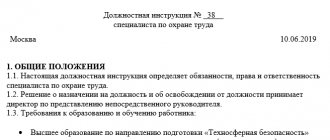Conducting unscheduled training on labor protection
After reading the article, you will learn how and when an unscheduled briefing is carried out, what information needs to be included in the order for an unscheduled labor safety briefing, and you will also understand the nuances of this type of briefing.
Unscheduled training on labor protection is carried out when something happens in the company or outside it that workers urgently need to know about. It is sometimes called an additional type of instruction, but it is not. Unscheduled briefing on labor protection is an absolutely self-sufficient type of instructing workers, intended for special cases.
Who passes
Unscheduled briefing is both a group and individual procedure. The head of the organization, by local act, determines the list of employees who need to be trained in labor protection.
Such employees may be:
- those who have violated safety rules during their work activities or had an unsatisfactory assessment based on the results of a previous occupational safety inspection;
- employees of the unit where the accident occurred;
- all employees of the enterprise.
Read more: Application for termination of contract with a driving school sample
https://youtu.be/BKjnun3uYTQ
When is an unscheduled safety briefing carried out?
Unscheduled instruction is carried out when the need arises. Its peculiarity is that it is almost impossible to plan it in advance. The main reasons for conducting unscheduled training on labor protection may be:
1. Entry into force of new regulations on a state scale.
2. Identified violations during internal inspections of the enterprise - by the safety commission, safety engineer, work manager.
3. Identified violations during inspections by supervisory and control authorities - labor inspector, state energy supervision, metrology service, etc.
4. Changes in working conditions: innovations in technological processes, new equipment, stopping the unit for repairs, changing the tools used, etc.
5. Changes in the organization of work: the planned arrival of trainees, the organization of excursions, the admission of workers from third-party organizations to the territory of the enterprise, changes in the working regime.
6. An emergency situation in an organization, its division or in an enterprise with similar production processes: injury, confirmation of an occupational disease, accident, fire, explosion, etc.;
7. Requirement or recommendation of higher organizations, supervisory authorities in any of the company’s areas of activity (energy, fire safety, etc.).
8. Approval of new instructions, operating procedures, rules and other documents valid throughout the enterprise.
9. Conducting unscheduled training on labor protection is also mandatory for workers who have not worked in a specific type of work:
• increased danger – 30 days or more; • non-hazardous – 60 days or more.
Such breaks may occur due to long vacations, sick leave, business downtime, business trips, government or public duties, or other reasons. It is impossible to predict the occurrence of the above events in advance and plan appropriate instructions, which is why it is called unscheduled.
About conducting briefings
Some types of instructions.
A number of safety measures include conducting occupational safety training.
Types of briefings and why they are carried out:
- introductory. An employee who reappears at the enterprise does not know many of the nuances of the territory and the rules of being on site. In view of these circumstances, the employee involved in labor protection conducts instruction, which is recorded with the signatures of both parties in a special journal;
- primary. Arriving at the workplace, a new employee does not know production technology, how to turn on and off the equipment entrusted to him, or what personal protective equipment is required. Familiarity with the listed nuances is ensured by the immediate supervisor. The briefing is recorded in the journal with signatures and dates;
- repeated. This briefing is exactly the same as the initial one and is conducted by the same employee. The need for the behavior is to repeat what has been learned and act as a reminder of workplace safety. Information about the repeated briefing is entered into a log;
- target. If an employee is directed to perform other tasks that he can do and is not contraindicated for health reasons, then the manager conducts this instruction.
The purpose of the event is to familiarize yourself with safe work practices.
The signatures of the person who conducted and received the instruction are entered in the journal and are reflected in the permit;
- extraordinary briefing. This is another type of instruction, about which more information will be provided.
How to conduct an unscheduled briefing on labor protection?
Organizing an unscheduled safety briefing is quite simple. To do this you need:
• have a document that clearly defines the need for unscheduled instruction. This could be a notice of an accident, breakdown, fire and their consequences, a new version of a law or regulation, an order from a regulatory body or a higher organization, etc. This document will need to be referenced in the order for unscheduled instruction on labor protection;
• prepare an order for unscheduled instruction on labor protection, which will indicate the reason for organizing the instruction, the instructor, the location of the instruction, the persons who are required to undergo it, and the timing;
• prepare and approve the instruction program. It can be common for all instructees or separate for workers of different positions and professions. Before approval, the unscheduled instruction program is agreed upon by the labor protection service and the trade union committee;
• organize instruction: explain new information to workers, test knowledge, make entries in the journal.
The law requires that the person instructing employees must first be trained in the requirements of the rules or instructions whose provisions are explained. Therefore, before conducting an unscheduled briefing on labor protection on this topic, it is necessary to organize training in new or amended regulations for the instructors themselves.
At the end of the instruction, its results are entered into the instruction log in the same order as after the initial, repeated and targeted instructions. If an organization maintains personal OT training records, then they too. The knowledge test is carried out in a form convenient for the instructing person. Most often this is an oral survey, although testing and automated knowledge testing can also be used. If the program included a demonstration of safe work practices, the level of development of these skills among workers should be checked.
Unscheduled instruction is carried out for each worker separately or for a group of people of the same (related) professions who must be trained according to the same programs. Depending on the characteristics of a particular program, instruction can be carried out at workplaces or in specially equipped rooms (lecture rooms, assembly halls, etc.).
Workers who did not undergo unscheduled instruction within the period established by the order or showed unsatisfactory quality of knowledge are not allowed to perform work. To be cleared to work, they must undergo training for the first time (if they were not present) or again (if they did not pass the knowledge test). For workers who are not allowed to work and who evade instructions, their earnings during this time are not saved.
Documentation and registration
Records of unscheduled briefings, as well as other forms of reporting on training in the basics of labor protection, fall under administrative responsibility. The logbook for such briefings is approved by GOST 12.0.004-90.
The following information is entered into this log:
- about the reason for conducting the briefing outside the plan;
- its date;
- personal information and position of the instructor;
- about persons who have undergone instruction;
- about its volume and content.
This is interesting: Requirements for filling out travel forms 2020
This information is sealed with the signatures of the instructor and each person instructed.
If an employee's personal card , information about unscheduled briefings is also entered into it, and the number or name of the corresponding program is indicated.
Unscheduled briefing on labor protection: features, responsible persons and timing
The main feature of unscheduled instruction is the absence of a pre-developed and approved program. Therefore, in order to prepare as much as possible for this type of instruction, it is worth drawing up a procedure for developing and approving a program for typical cases (changes in the requirements of regulatory documentation, an accident, identification of unsatisfactory knowledge of occupational safety, etc.).
When an unscheduled briefing on labor protection is carried out in connection with changes or the entry into force of new rules, codes, GOSTs and other regulatory documentation of state importance, it can be carried out in whole or in part by inviting a state inspector, employees of the training center, and other specialists who have already been trained in these regulations. To avoid any discrepancies, this possibility should be discussed in advance with the inspector who supervises the specific organization.
Responsibility for organizing unscheduled instruction, as well as other types of occupational safety training, lies with the employer and the persons to whom he has entrusted this task. Most often these are the immediate supervisors of the work.
The timing of unscheduled instruction depends on its reason. If this is a change in the technological process, the use of new equipment, etc., then instruction must be carried out before the start of work under new conditions. If it is necessary to bring to the attention of workers information about violations of occupational safety requirements at similar enterprises, accidents, etc., the period for conducting instructions is established by the management of the organization.
Why was instruction needed outside of the plan?
Should training in certain basics of labor protection be carried out outside the approved plan and program? This requires a certain reason provided for by labor legislation.
Reasons for unscheduled briefing:
- reaction to a sudden emergency situation;
- the need for training in response to changes in working conditions, technology or equipment.
Reasons for scheduling an unscheduled briefing
They fit into the two reasons listed above. Specific reasons requiring new training, noted in regulations, may be:
- introduction of new or revised standards, instructions, rules related to labor protection at a given enterprise;
- introducing any changes to existing labor safety regulations;
- introduction of new factors into the production process: change or renewal of equipment, tools, raw materials, replacement of technologies, etc.;
- requirement set by supervisory authorities;
- identified violation of labor safety requirements committed by employees or students, which led or could lead to damage to health or equipment;
- information received about accidents or accidents at similar enterprises;
- an interval of more than 2 months between permits to work, and for work in conditions of increased danger - more than 1 month.
More danger means more training requirements
If production is characterized by a greater degree of danger, in order to prevent injuries and emergency situations, unscheduled briefings must be carried out for additional reasons. These may include:
- getting injured at work;
- a month's break in the employee's work activity;
- the occurrence of an occupational disease in one or more employees due to working conditions;
- forced change of schedule or stop of the work process due to gross violation of labor safety rules;
- the employee is transferred to a new workplace;
- the employer or control body has issued a corresponding order.
IMPORTANT! If the reason was an accident or injury at this or another workplace. Then the briefing must be carried out “hot on the heels” - no later than three days after the incident.









